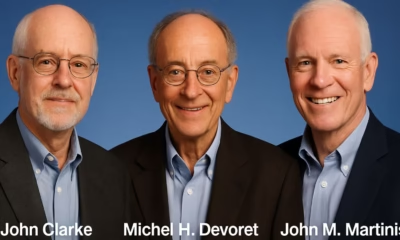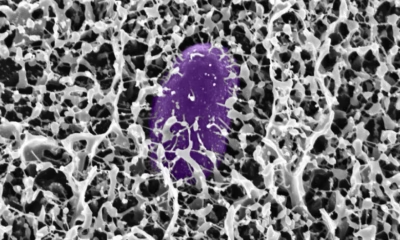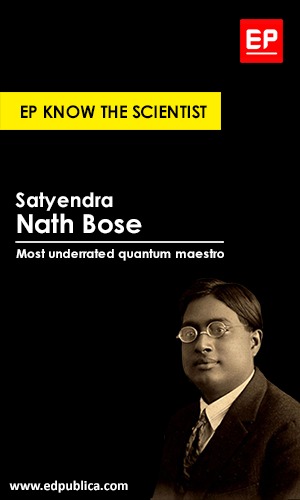Know The Scientist
Remembering the enigmatic Meghnad Saha
The enigmatic Indian scientist who left lasting legacy in both astrophysics and Indian science.

Meghnad Saha played against the popular norms of his time. That’s what people who stand out from a crowd do. His temerity was one of a kind, that either displeased people too much that ended up getting him marginalized. But he was undoubtedly shaped by the tumultuous era he grew up in, when the talk of an independent India would captivate his imagination.

Saha was born in Dhaka in 1893 when it was still part of Bengal. At some 12 years of age in 1905, Saha was expelled from school – by his Englishman headmaster- for protesting against Joseph Fuller, the Viceroy for Eastern Bengal and Assam – following then Viceroy Lord Curzon’s unilateral partition of Bengal was unfolding.
His outspoken candor could’ve cost him his education, having grown up in a not so well-off family. But where his boldness cost him, he had well-wishing sponsors funding his incredible academic talent.
However, he had his difficulties. On one end, he experienced caste discrimination – being Dalit – from his fellow students at Presidency College, Calcutta where he did his bachelors and master’s degrees in applied mathematics.
But he found support and camaraderie in the future quantum physics maestro, Satyendra Nath Bose. Back then a student, Bose and Saha would have numerous engagements as colleagues, when they graduated with their applied mathematics’ degrees to be recruited as lecturers in physics at the University College of Calcutta.
From left: S.N. Bose (standing second) and Saha (standing fourth). Credit: Wikimedia
Despite not having a formal training in physics, his job requirements meant he had to be up-to-date with the latest developments. And that’s when Saha discovered and investigated a problem plaguing astronomers. Astronomers in the 1910s had trouble linking spectra of stars to their actual surface temperatures.
But Saha entered the fray, lending a solution that would ultimately bear his name – the Saha thermal ionization equation.
D.S. Kothari, the Indian physicist wrote an obituary for Saha following his death, quoting Saha saying,“It was while pondering over the problems of astrophysics, and teaching thermodynamics and spectroscopy to the MSc classes that the theory of thermal ionization took a definite shape in my mind in 1919.”
“While reading Eggert’s paper I saw at once the importance of introducing the value of ionization potential in the formula of Eggert, for calculating accurately the ionization, single or multiple, of any particular element under any combination of temperature and pressure.”
But one of the major misconceptions out in the public domain is that Saha came up first with that equation. The physicist Arnab Rai Choudhuri notes it was the physicist John Eggert, who derived the formula purely to describe thermodynamic phenomena. The equation can estimate the fraction of gas that will become ionized at a certain temperature and pressure. Frederick Lindemann later realized its application in astronomy to estimate ionization fractions in hydrogen-species. But he couldn’t extend that for the rest of the chemical elements. Saha’s genius was in generalizing that expression. He had visited Europe’s laboratories during a year’s stint at experimental laboratories breaking into new frontiers of quantum physics. His findings provided clarity on how both temperature and pressure directly affected concentration of ions in the sun’s chromosphere.
Stars with distinct colors captured during the Sloan Digital Sky Survey. Credit: SDSS /Wikimedia
Svein Rosseland, the Norwegian astrophysicist remarked in his textbook, Theoretical Astrophysics, “The impetus given to astrophysics by Saha’s work can scarcely be overestimated, as nearly all later progress in this field has been influenced by it, and much of the subsequent work has the character of refinements of Saha’s ideas.”
His achievements got him a ticket to become an elected member of the UK’s Royal Society. However, it came only after some hesitation, with Saha’s anti-British political activism coming to light.
The political situation in British India had never acquired so much steam as it did in 1919, before Saha’s stint in Europe two years later began. The Jallianwala Bagh massacre in Punjab shook Saha to the core, said historian Soma Banerjee.
Saha saw respite in physics, when he dealt with his own flailing personal life. Returning back to India, Saha cemented himself as a physicist with some stature. However, he now made it a point to put his feet in the political arena as he saw it useful to articulate his concerns and visions for a new India that they believed would soon rise above the horizon.
Saha, being facilitated after his election as Lok Sabha (Indian Parliament) MP in 1952. Credit: Wikimedia
In 1937, Jawaharlal Nehru, who would later become the first Prime Minister of India, said, “It was science alone that could solve these problems of hunger and poverty, of insanitation and illiteracy, of superstition and the deadening custom and tradition, of vast resources running to waste, of a rich country inhabited by starving people.” He’d be credited with what historians of science would call, Nehruvian Science – a series of ambitious pronouncements laden in Nehru’s speeches that aims for science and technology to rewrite Indian historiography. He said statements mounting to invoking national pride for science, to build and develop infrastructure for Indians that the British failed to invest on.
The Damodar River Valley project that now powers light bulbs across Bengal and neighboring states in India, was a brainchild of Saha
However, the scholar Shiv Visvanathan recognized much of Nehruvian Science’s dogma to Saha himself. David Arnold, the historian of science, calls Saha the ‘innovator’ – while lending a more nuanced picture that historians since the 1980s have taken in over Nehruvian Science being anything but Nehru’s sole contribution.
The Damodar River Valley project that now powers light bulbs across Bengal and neighboring states in India, was a brainchild of Saha. He lobbied hard for river planning in free India, having first hand experience surviving a flood in Bengal when he was young.
Saha grew a rapport with nationalist leader and icon, Subhas Chandra Bose, in 1937, when he was the president of the Congress party in 1937. He discussed his national regeneration plan with Bose, which Arnold notes was reflected in Bose’s speeches since then. Saha requested Bose to have Nehru lead the Indian Planning Committee – based on the Soviet model of state planning and the American New Deal that inspired Saha so much.
However, Saha had a degree of fallout with Nehru since then once India was independent at last. Saha was an advocate of atomic energy for peaceful purposes, while Homi Bhabha – another visionary scientist – was favored by Nehru.
In 1952, Saha contested Lok Sabha elections as an independent candidate and won. By then Saha was out of Nehru’s purview, although he worked hard enough on his regenerative projects, until his death in 1956.
Perhaps looking backwards, Saha’s legacy is enshrined in the numerous physics departments he made during his time. India had its first cyclotron in 1950, at the now renamed Saha Institute of Nuclear Physics in Kolkata. He was undoubtedly a mascot institution builder.
Saha (on the right) with his assistants next to the cyclotron, Credit: Wikimedia
However, he was embedded in some pointed battles with Homi Bhabha and Vikram Sarabhai – while being courteous at the same time – on how Indian science must progress.
Saha was a proponent of pushing science from the grassroots in a bottom-up approach, unlike Bhabha or Sarabhai.
Dr Anil Kakodkar, a former student of Homi Bhabha, nuclear physicist and former director at the Bhabha Atomic Research Centre – BARC – spoke to journalist Shekhar Gupta in 2022. “Saha, probably because he had seen deprivation and discrimination, wanted even science to grow from the grassroots,” wrote Gupta. “Bhabha, the entitled aristocrat (as Saha saw him), would rather make spectacular achievements in limited areas and catapult India to some kind of leadership position. Unlike Bhabha or Sarabhai, or scientists generally at any time, Saha was a political risk-taker.”
One of the reasons why Nehruvian Science didn’t really manifest into having Indian science thrive the way it could be, was because they didn’t invest in education or research for local universities
In retrospect, Saha did make some valid points about the need for India requiring grassroot building. One of the reasons why Nehruvian Science didn’t really manifest into having Indian science thrive the way it could be, was because they didn’t invest in education or research for local universities. Instead, funds would be diverted to central laboratories for research – with no net gain either.
Perhaps, India needs another Meghnad Saha-like figure today. The time is ripe for it, more than ever before.
Know The Scientist
Remembering S.N. Bose, the underrated maestro in quantum physics
Rejected in Britain, celebrated by Einstein, here’s the story of S.N. Bose, the Indian physicist who formulated quantum statistics, now a bedrock theory in condensed matter physics.
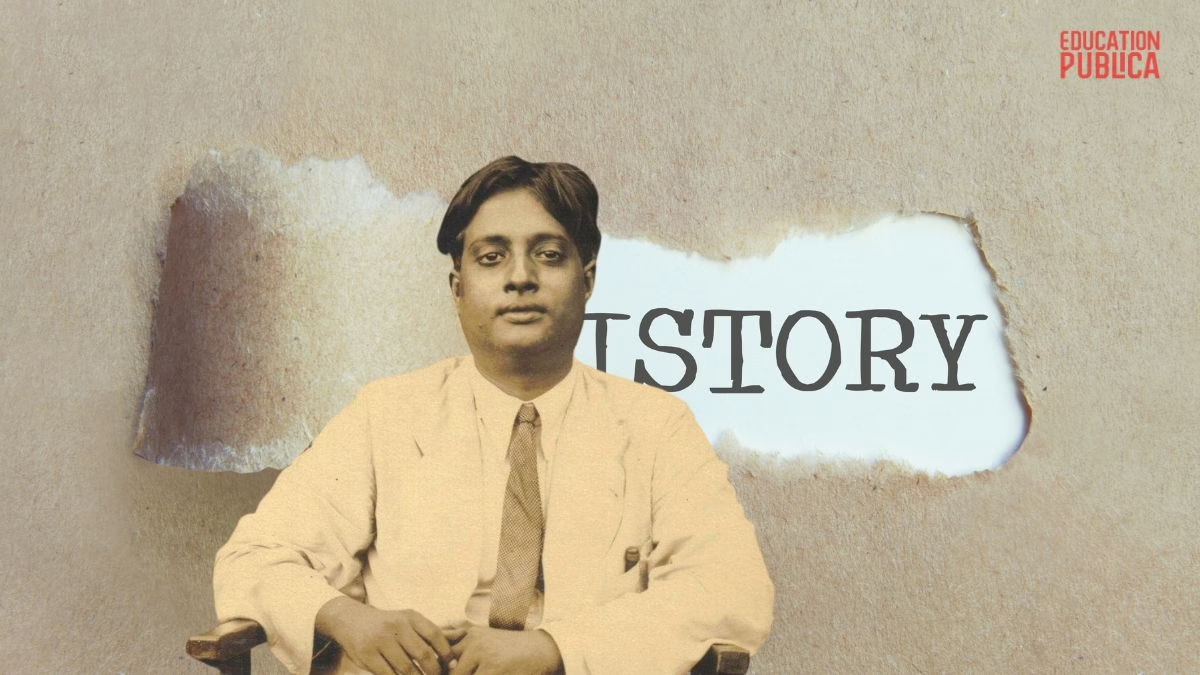
It’s 1924, and Satyendra Nath Bose, going by S.N. Bose was a young physicist teaching in Dhaka, then British India. Grappled by an epiphany, he was desperate to have his solution, fixing a logical inconsistency in Planck’s radiation law, get published. He had his eyes on the British Philosophical Magazine, since word could spread to the leading physicists of the time, most if not all in Europe. But the paper was rejected without any explanations offered.
But he wasn’t going to give up just yet. Unrelenting, he sent another sealed envelope with his draft and this time a cover letter again, to Europe. One can imagine months later, Bose breathing out a sigh of relief when he finally got a positive response – from none other than the great man of physics himself – Albert Einstein.
In some ways, Bose and Einstein were similar. Both had no PhDs when they wrote their treatises that brought them into limelight. And Einstein introduced E=mc2 derived from special relativity with little fanfare, so did Bose who didn’t secure a publisher with his groundbreaking work that invented quantum statistics. He produced a novel derivation of the Planck radiation law, from the first principles of quantum theory.
This was a well-known problem that had plagued physicists since Max Planck, the father of quantum physics himself. Einstein himself had struggled time and again, to only have never resolved the problem. But Bose did, and too nonchalantly with a simple derivation from first principles grounded in quantum theory. For those who know some quantum theory, I’m referring to Bose’s profound recognition that the Maxwell-Boltzmann distribution that holds true for ideal gasses, fails for quantum particles. A technical treatment of the problem would reveal that photons, that are particles of light with the same energy and polarization, are indistinguishable from each other, as a result of the Pauli exclusion principle and Heisenberg’s uncertainty principle.
Fascinated and moved by what he read, Einstein was magnanimous enough to have Bose’s paper translated in German and published in the journal, Zeitschrift für Physik in Germany the same year. It would be the beginning of a brief, but productive professional collaboration between the two theoretical physicists, that would just open the doors to the quantum world much wider. Fascinatingly, last July marked the 100 years since Einstein submitted Bose’s paper, “Planck’s law and the quantum hypothesis” on his behalf to Zeitschrift fur Physik.
With the benefit of hindsight, Bose’s work was really nothing short of revolutionary for its time. However, a Nobel Committee member, the Swedish Oskar Klein – and theoretical physicist of repute – deemed it a mere advance in applied sciences, rather than a major conceptual advance. With hindsight again, it’s a known fact that Nobel Prizes are handed in for quantum jumps in technical advancements more than ever before. In fact, the 2001 Nobel Prize in Physics went to Carl Wieman, Eric Allin Cornell, and Wolfgang Ketterle for synthesizing the Bose-Einstein condensate, a prediction made actually by Einstein based on Bose’s new statistics. These condensates are created when atoms are cooled to near absolute zero temperature, thus attaining the quantum ground state. Atoms at this state possess some residual energy, or zero-point energy, marking a macroscopic phase transition much like a fourth state of matter in its own right.
Such were the changing times that Bose’s work received much attention gradually. To Bose himself, he was fine without a Nobel, saying, “I have got all the recognition I deserve”. A modest character and gentleman, he resonates a lot with the mental image of a scientist who’s a servant to the scientific discipline itself.
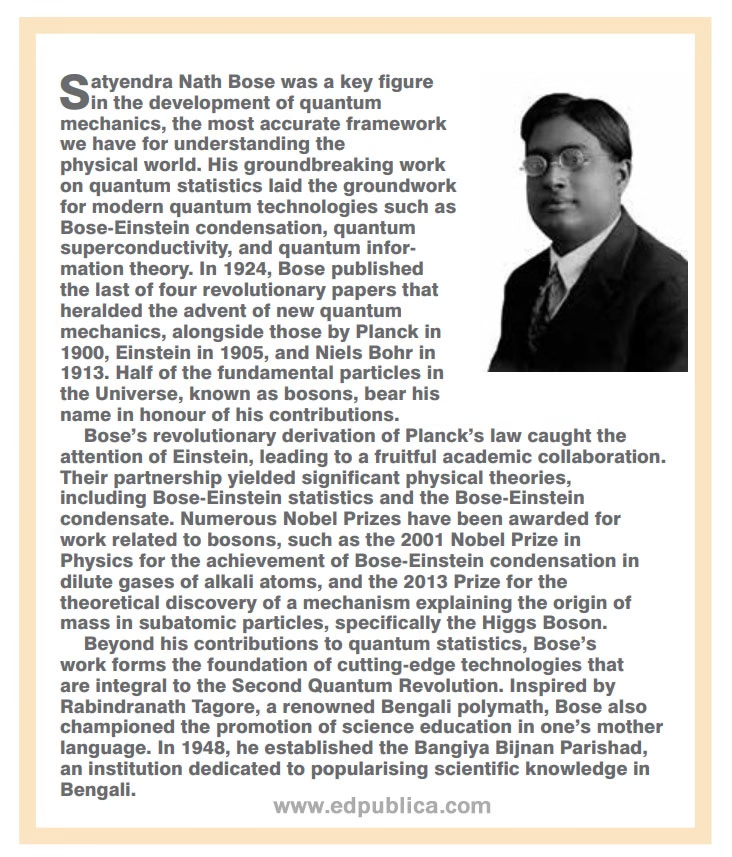
But what’s more upsetting is that, Bose is still a bit of a stranger in India, where he was born and lived. He studied physics at the Presidency College, Calcutta under the tutelage that saw other great Indian physicists, including Jagdish Chandra Bose and Meghnad Saha. He was awarded the Padma Vibhushan, the highest civilian award by the Government of India in 1954. Institutes have been named in his honour, but despite this, his reputation has little if no mention at all in public discourse.
To his physicists’ peers in his generation and beyond, he was recognized in scientific lexicology. Paul Dirac, the British physicist coined the name ‘bosons’ in Bose’s honor (‘bose-on’). These refer to quantum particles including photons and others with integer quantum spins, a formulation that arose only because of Bose’s invention of quantum statistics. In fact, the media popular, ‘god particle’, the Higgs boson, carries a bit of Bose as much as it does of Peter Higgs who shared the 2013 Nobel Prize in Physics with Francois Euglert for producing the hypothesis.
Know The Scientist
Narlikar – the rare Indian scientist who penned short stories
Jayant Narlikar has been one of the most prolific scientists, and science communicators India has ever produced. The octogenarian had died at his residence in Pune.
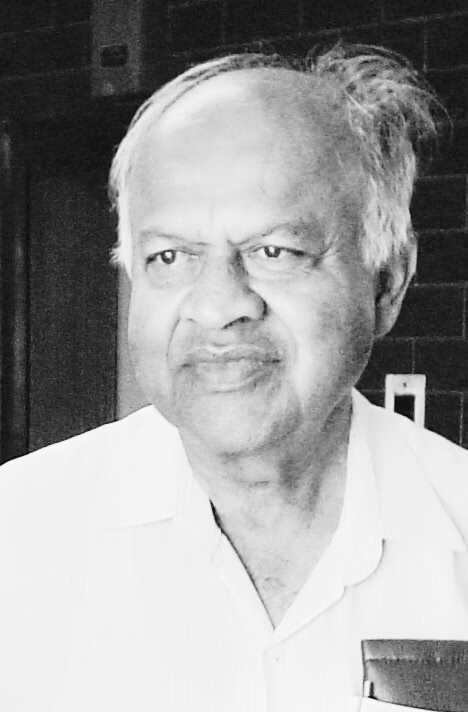
Jayant Narlikar passed away at his Pune residence on Tuesday. He was 86-years old, and had been diagnosed with cancer. With his demise, India lost a prolific scientist, writer, and institution builder.
In 2004, the government of India had honored Narlikar with the Padma Vibhushan, the second-highest civilian award, for his services to science and society. But that was not his first recognition from the Indian government. At the age of 26, he had received his first Padma Bhushan, in recognition for his work in cosmology, studying the universe’s large-scale structures. He helped contribute to derive Einstein’s field equations of gravity from a more general theory. That work, dubbed the Narlikar-Hoyle theory of gravity, was borne out a collaboration with Narlikar’s doctoral degree supervisor at Cambridge; Fred Hoyle, the then leading astrophysicist of his time.
Narlikar and the steady-state theory
Narlikar and Hoyle bonded over a shared skepticism towards the prevalent Big Bang hypothesis, which sought to extrapolate the universe’s ongoing expansion to its birth at some finite time in the past. However, Narlikar and Hoyle could not have been more opposed, mostly out of their own philosophical beliefs. They drew upon the works of 19th century Austrian physicist and philosopher, Ernest Mach, in rejecting a theory discussing the universe’s beginning in the absence of a reference frame. As such, Narlikar was a strong proponent of Hoyle’s steady-state model of the universe, in which the universe is infinite in extent, and indefinitely old. As such, the steady-state theorists explained away the universe’s expansion to matter being spawned into existence from this vacuum at every instant, aka a C-field.
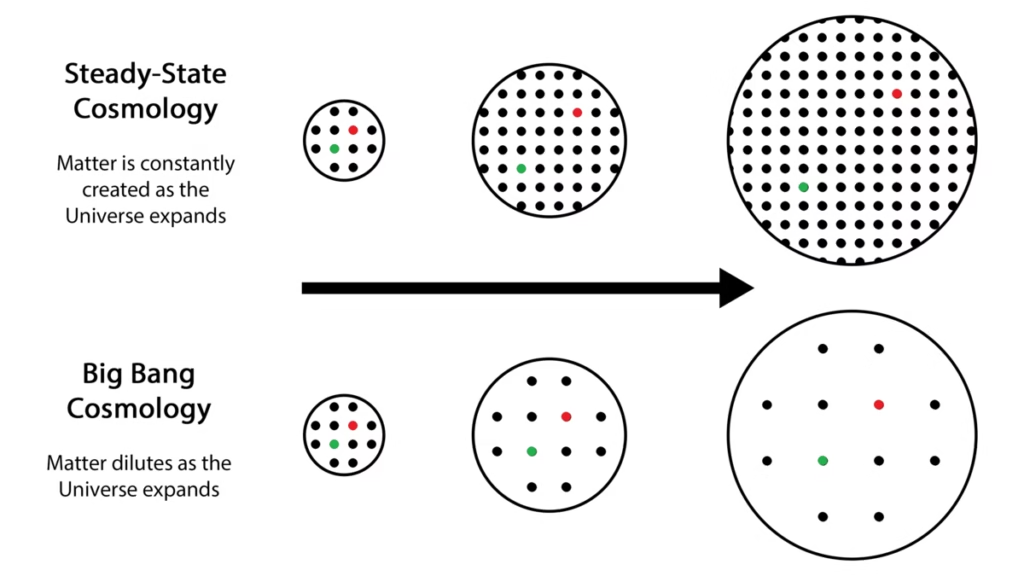
However, the steady-state’s predictions did not hold up in face of evidence the universe expands over time. Nor did its successive avatar, the quasi-steady state theory devised sway scientific consensus. The death knell came when evidence of the cosmic microwave background (aka the CMB) was discovered in 1964.
Despite steady-state’s failure, it provided healthy rivalry to the Big Bang from the 1940s to the 60s, providing opportunities for astronomers to compare observations to precise predictions. In the words of the Nobel laureate Steven Weinberg, “In a sense, this disagreement is a credit to the model; alone among all cosmologies, the steady state model makes such definite predictions that it can be disproved even with the limited observational evidence at our disposal.”
The Kalinga winning short-story writer
Narlikar was more than just a cosmologist, studying the large-scale structure of the universe. He also had been an acclaimed science fiction writer, with his works penned in English, Hindi, and in his vernacular, Marathi. His famous work was a short-story, Dhoomekethu (The Comet), revolving around themes of superstition, faith, rational and scientific thinking. Published in Marathi in 1976, with translations available in Hindi, the story was adapted later into a two-hour film bearing the same name. In 1985, the film aired on the state-owned television broadcasting channels, Doordarshan.
In a way, he was India’s Carl Sagan, airing episodes explaining astronomical concepts, with children being his target audience. The seventeen-episode show, Brahmand (The Universe), aired in 1994, to popular acclaim. One of his most popular books, Akashashi Jadle Nathe (Sky-Rooted Relationship), remains popular. An e-book version in Hindi is available on Goodreads, with 470 reviewers lending an average rating of 4.7 out of 5.
His efforts was honored with an international prize. In 1996, he received the much-coveted Kalinga Prize for the Popularization of Science, awarded annually in India by the United Nations Educational, Scientific and Cultural Organization (UNESCO), “in recognition of his efforts to popularize science through print and electronic media.” Narlikar had been only the second Indian at the time, after the popular science writer Jagjit Singh, to have received the award.
When Narlikar returned to India, accepting a position at the Tata Institute of Fundamental Research (TIFR), he realized that the fruits of astrophysical research did not flourish outside central institutions. Though Bengaluru had an Indian Institute of Astrophysics, Narlikar envisioned basing a research culture paralleling his time at Cambridge. Hence, the Inter-University Centre for Astronomy and Astrophysics (IUCAA) was born in 1988, and Narlikar was appointed its founding director. Arguably, his most visible legacy would have been to shape India’s astrophysical research culture through his work with the IUCAA (pronounced “eye-you-ka”).
Know The Scientist
Dr. Nikku Madhusudhan Brings Us Closer to Finding Life Beyond Earth
Dr. Madhusudhan, a leading Indian-British astrophysicist at the University of Cambridge, has long been on the frontlines of the search for extraterrestrial life

Somewhere in the vast, cold dark of the cosmos, a planet orbits a distant star. It’s not a place you’d expect to find life—but if Dr. Nikku Madhusudhan is right, that assumption may soon be history.
Dr. Madhusudhan, a leading Indian-British astrophysicist at the University of Cambridge, has long been on the frontlines of the search for extraterrestrial life or what we call the alien life. This month, his team made headlines around the world after revealing what could be the strongest evidence yet of life beyond Earth—on a distant exoplanet known as K2-18b.
Using data from NASA’s James Webb Space Telescope, Madhusudhan and his collaborators detected atmospheric signatures of molecules commonly associated with biological processes on Earth—specifically, gases produced by marine phytoplankton and certain bacteria. Their analysis suggests a staggering 99.7% probability that these molecules could be linked to living organisms.
“This marked the first detection of carbon-bearing molecules in the atmosphere of an exoplanet located within the habitable zone,” the University of Cambridge said in a press statement. “The findings align with theoretical models of a ‘Hycean’ planet — a potentially habitable, ocean-covered world enveloped by a hydrogen-rich atmosphere.”
Born in India, Dr. Madhusudhan began his journey in science with an engineering degree from IIT (BHU) Varanasi
In addition, a fainter signal suggested there could be other unexplained processes occurring on K2-18b. “We didn’t know for sure whether the signal we saw last time was due to DMS, but just the hint of it was exciting enough for us to have another look with JWST using a different instrument,” said Professor Nikku Madhusudhan in a news report released by the University of Cambridge.
The man behind the mission
Born in India, Dr. Madhusudhan began his journey in science with an engineering degree from IIT (BHU) Varanasi. But it was during his time at the Massachusetts Institute of Technology (MIT), under the mentorship of exoplanet pioneer Prof. Sara Seager, that he found his calling. His doctoral work—developing methods to retrieve data from exoplanet atmospheres—would go on to form the backbone of much of today’s planetary climate modeling.
Now a professor at the University of Cambridge’s Institute of Astronomy, Madhusudhan leads research that straddles the line between science fiction and frontier science.
A Universe of Firsts
Over the years, his work has broken new ground in our understanding of alien worlds. He was among the first to suggest the concept of “Hycean planets”—oceans of liquid water beneath hydrogen-rich atmospheres, conditions which may be ideal for life. He also led the detection of titanium oxide in the atmosphere of WASP-19b and pioneered studies of K2-18b, the same exoplanet now back in the spotlight.
His team’s recent findings on K2-18b may be the closest humanity has ever come to detecting life elsewhere in the universe.
Accolades and impact
Madhusudhan’s contributions have earned him global recognition. He received the prestigious IUPAP Young Scientist Medal in 2016 and the MERAC Prize in Theoretical Astrophysics in 2019. In 2014, the Astronomical Society of India awarded him the Vainu Bappu Gold Medal for outstanding contributions to astrophysics by a scientist under 35.
But for Madhusudhan, the real reward lies in the questions that remain unanswered.
Looking ahead
Madhusudhan cautions that, while the findings are promising, more data is needed before drawing conclusions about the presence of life on another planet. He remains cautiously optimistic but notes that the observations on K2-18b could also be explained by previously unknown chemical processes. Together with his colleagues, he plans to pursue further theoretical and experimental studies to investigate whether compounds like DMS and DMDS could be produced through non-biological means at the levels currently detected.
Beyond the lab, Madhusudhan remains dedicated to mentoring students and advancing scientific outreach. He’s a firm believer that the next big discovery might come from a student inspired by the stars, just as he once was.
As scientists prepare for the next wave of data and the world watches closely, one thing is clear: thanks to minds like Dr. Nikku Madhusudhan’s, the search for life beyond Earth is no longer a distant dream—it’s a scientific reality within reach.
-

 Space & Physics5 months ago
Space & Physics5 months agoIs Time Travel Possible? Exploring the Science Behind the Concept
-

 Earth6 months ago
Earth6 months ago122 Forests, 3.2 Million Trees: How One Man Built the World’s Largest Miyawaki Forest
-

 Space & Physics6 months ago
Space & Physics6 months agoDid JWST detect “signs of life” in an alien planet?
-
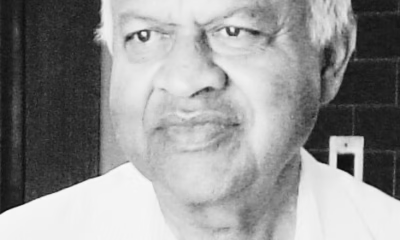
 Know The Scientist5 months ago
Know The Scientist5 months agoNarlikar – the rare Indian scientist who penned short stories
-

 Society4 months ago
Society4 months agoShukla is now India’s first astronaut in decades to visit outer space
-

 Society4 months ago
Society4 months agoAxiom-4 will see an Indian astronaut depart for outer space after 41 years
-

 Earth4 months ago
Earth4 months agoWorld Environment Day 2025: “Beating plastic pollution”
-

 Society6 months ago
Society6 months agoRabies, Bites, and Policy Gaps: One Woman’s Humane Fight for Kerala’s Stray Dogs



